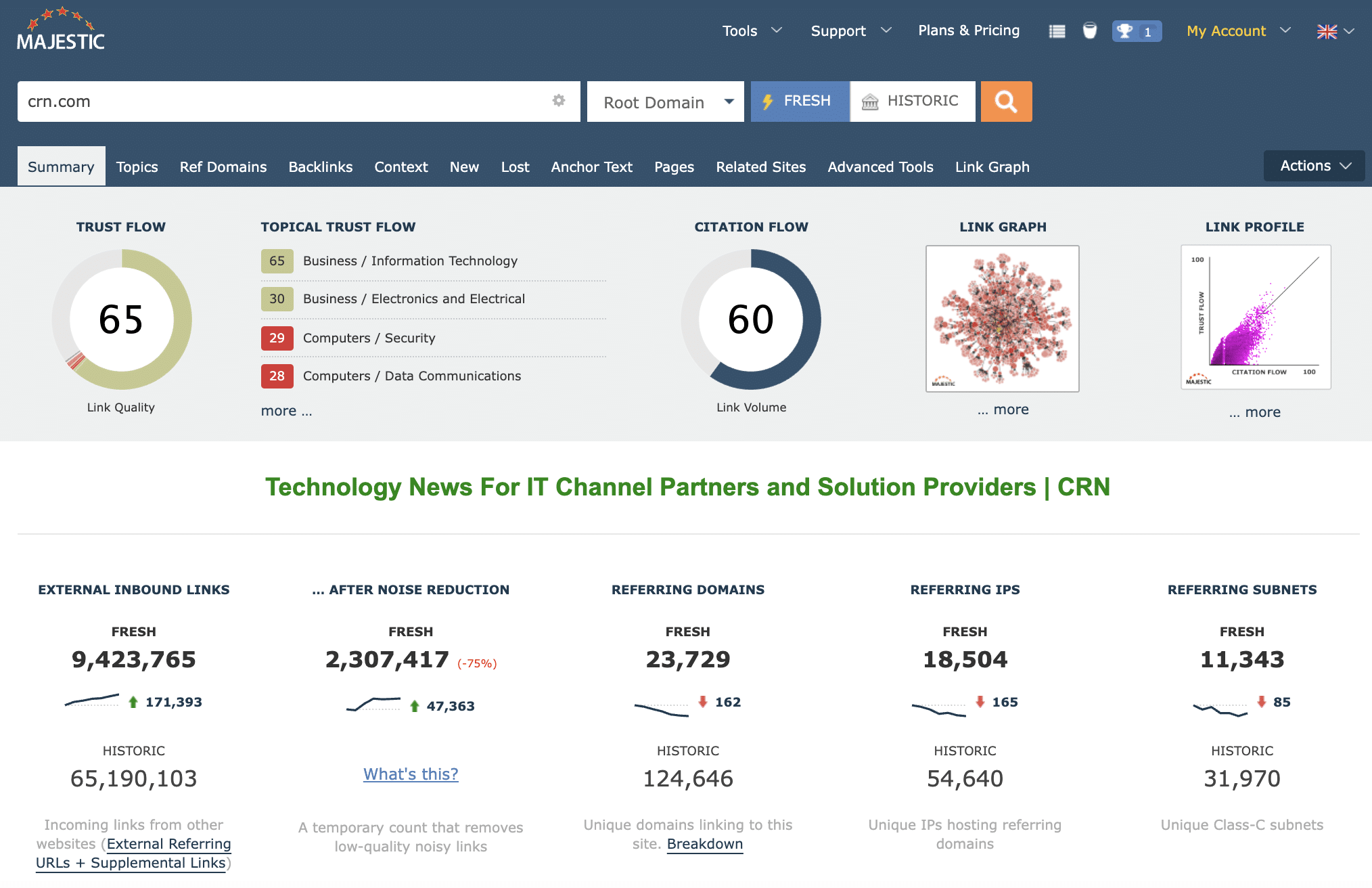What is Majestic SEO Trust Flow?
Improving how your business attracts leads organically usually means optimising your website so that it is increasingly visible to people on search engines like Google and Bing and attracts more net new prospects you can convert to leads.

Search engine optimisation (SEO) and search intent driven content are major contributors to this.
Making improvements requires measurement, but SEO is hard to measure. With so many variables, algorithm changes, market movements and other contributing factors, it’s challenging to find a direct like-for-like correlation between specific SEO activities and specific outcomes. This is especially the case when some of the major benefits of SEO activities have a longer-term Time to Impact.
Measuring SEO and search engine performance can include monitoring online visibility, keyword rankings, organic search clicks, Click-Through Rate (CTR) and site traffic, backlink and referring domain volumes and a wide range of other measurable metrics.
There is one metric which may be one of the more critically important to measure for your long-term SEO and digital marketing success.
It’s called Trust Flow.
Table of Contents
- What is Trust Flow?
- Why track Trust Flow as a metric?
- How do you measure “trust”?
- How does trust “flow”?
- Why should B2B tech companies measure Trust Flow?
- Is Trust Flow a ranking factor for search engines?
- What is Citation Flow?
- What is the difference between Trust Flow and Citation Flow?
- What is Topical Trust Flow?
- What is Majestic SEO?
What is Trust Flow?
According to Majestic, Trust Flow “represents the quality of links that point to URLs and websites.”
Trust Flow is expressed as a Trust Flow score between 0 and 100. The higher the number, the stronger the signal.
Since Trust Flow represents the quality of a site’s backlinks profile, it does not represent the total amount of links pointing to a website.
Why Track Trust Flow As a Metric?
In most marketing mixes, a website represents a company’s most significant marketing asset. It’s a key hub for marketing and demand generation. Increasing a brand’s online prominence becomes an vital marketing activity to increase organic traffic and organic lead acquisition. That’s why SEO is so important, but it is challenging to measure and report on.
Different SEO tools use different measurements. For example, Ahrefs uses Domain Ranking (DR) and URL Ranking (UR). Another example is Moz which uses Domain Authority (DA) and Page Authority (PA), or there is also a Semrush trust score called Authority Score (AS). These each have similarities but also major differences to Majestic Trust Flow.
Google formerly featured a reliable PageRank algorithm, but phased it out in the 2010s. (Source)
It’s the uniqueness of a Trust Flow score as measurement of a site’s Trust Flow that makes it a valuable metric to measure and improve over time. So if you’re now asking “how do I improve my trustflow score”, read on.
How Do You Measure “Trust”?
Trust Flow is a metric “weighted by the number of clicks from a seed set of trusted sites to a given URL, or Domain”. It’s measured by a complex Flow Metric Algorithm developed by Majestic.
But what does this mean in simple terms?
It all starts with ‘seed sites’. Majestic identified a set of highly authoritative seed websites as a baseline. Which sites were considered seed sites hasn’t been disclosed, but it’s likely these sites are wholeheartedly trusted by search engines. Think sites like Wikipedia, Government-owned sites, mainstream news sites, manually-edited directories, content published as a guest post on authoritative sites and so on.
The seed set of authority sites linking out to other good sites, and those sites linking out to more good sites, etc. The closer your domain is to these seed sites, via inbound links, the higher your Trust Flow score will be. High quality links means high trust flow. The further away your domain is from these authoritative sites, the lower your domain authority and trust flow will be. Spam links also detract from a trust score.
These factors, alongside the quality of links and other factors, make up the Flow Metric Algorithm and ultimately the basis for flow metrics.
Typically, a Trust Flow score of 50 and higher is considered great. Seed sites are likely in the 80s and 90s. A score between 11 and 49 is average, and a score of 10 or lower means a website is less trusted as an authority.
How Does Trust “Flow”?
As websites are linked to each other, trust “flows” through them.
Websites pass on trust to those websites they reference and link to. Higher trusted sites pass on more trust. The more a website is ‘trusted’ by highly trusted sites or even seed sites, the more its own trustworthiness with search engines increases.
That’s why the quality of backlinks is so important. In the same way quality content on your web pages is so important for user experience, quality backlinks and strategic link building is important for good trust flow, i.e. trustworthiness, and increasing higher trust to achieve online prominence on Google and other search engines.
In the example, you can see that trust originates with Site A (a seed site). As Site A is linked to Site B and so forth, trust flows through the websites and each respective Trust Flow metric diminishes.
Why Should B2B Tech Companies Measure Trust Flow?
Tracking and measuring data is core to the function of B2B tech companies. Leadership teams are continuously making evidence-based decisions based on insights from the data they collect. Whether it’s user experience improvements, providing scalable consumption, upgrading an SD-WAN network or expanding their IaaS zone availabilities, data is at the core.
No matter where a B2B tech company sits in an ecosystem, their website represents their most significant marketing asset of their business. It’s where their value proposition and differentiation is articulated, and is a key hub of their marketing and demand generation. It’s where you funnel most of your prospects and opt of funnel leads to. Many of your other lead source channels will point to your website to give you the opportunity to capture interest or intent from your prospects and leads.
Organic search, or people finding your website by searching topics or researching answers to their questions online, represents a significant source of attracting prospects and leads to your website based content, and therefore, your lead gen and sales funnel.
For those technology companies that are looking to increase organic lead acquisition and are investing in SEO, measuring Trust Flow makes a lot of sense. Understanding Trust Flow can also assist with selecting affordable SEO services for a small business.
Is Trust Flow a Ranking Factor For Search Engines?
Trust Flow as a metric was developed by Majestic, a third-party SEO tool. The specific metric of Trust Flow is not a ranking signal used by Google or any other search engine. While Google is known to have over 200 ranking factors, Trust Flow itself is not a ranking factor.
Trust Flow is based on some of the ranking factors though, such as backlinks. Since Google and other search engines don’t provide specific metrics relating to this topic, paying attention to and measuring Trust Flow in the context of backlinks can lead to positive outcomes for marketers and businesses looking to increase their authority online, attract more users organically to their site and engage with prospects to convert leads.
“As Majestic Flow Metric scores do not directly influence search engines, there is little to be gained in and of itself by seeking to enhance your Trust Flow or Citation Flow… SEO should result in an increase in your websites authority, and as a consequence, your Flow Metric scores. Any increase in the value of scores should be seen as a celebration of your success, rather than the cause of it,” according to Majestic.
What is Citation Flow?
According to Majestic, “Citation Flow is a score between 0-100 which helps to measure the link equity or ‘power’ the website or link carries. Citation Flow is used in conjunction with Trust Flow.”
When it comes to Citation Flow and trust, Citation Flow is the total quantity of links in a site’s backlink profile that point to a website. It makes no distinction between quality links and low quality links.
What Is the Difference Between Trust Flow and Citation Flow?
Trust Flow and Citation Flow are two metrics represented as a score that Majestic uses to identify, make sense of and track different types of backlinks to a website, such as guest posts, editorial backlinks as well as many other types.
Trust Flow represents the trustworthiness of a website by ascribing a score to the quality of the site’s backlink profile.
Since Citation Flow represents only the total quantity of backlinks, it does not indicate good vs less desirable quality backlinks to a website.
What is Topical Trust Flow?
Topical Trust Flow is a Majestic trademarked metric that provides website categorisation to understand topical relevancy. Website categories give marketers visibility of which industry sector their website has influence in.
According to Majestic, “Topical Trust Flow helps users find influencers for specific categories and easily determine if a link clear up is required. Topical Trust Flow provides a series of numbers, on a log based scale between 0-100. The number shows the relative influence of a web page, subdomain or root domain in any given topic or category.”
What is Majestic SEO?
Founded in 2004 in England, Majestic surveys and maps the internet and has created the largest commercial link intelligence database in the world. Majestic is constantly revisiting web pages and sees around a billion URLs a day.
This is used for a variety of purposes relating to online prominence, including link building, reputation management, website traffic development, competitor analysis and news monitoring.
Trust Flow, Citation Flow, Topical Trust Flow and other flow metrics are Majestic trademarks.
Want To Find Out How To Increase Your Site’s Trust Flow?
Every company always wants more organic leads, but you have to consider your website’s online prominence.
Contact us to identify how our SEO services can increase your organic channel acquisition.





